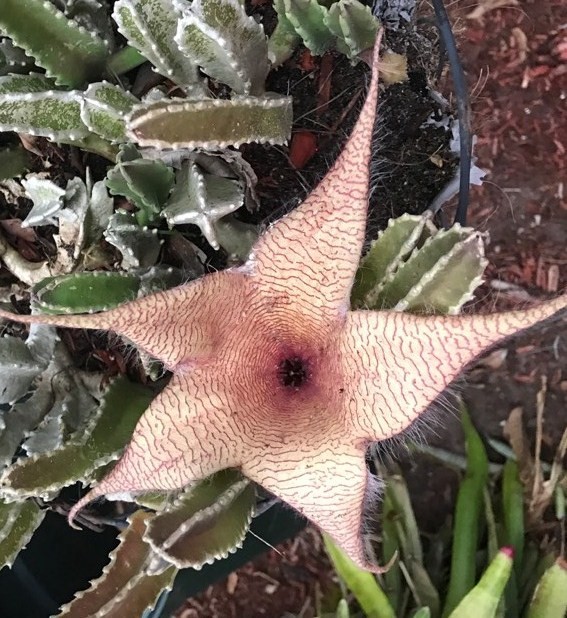Zulu giant
(Ceropegia gigantea)

Description
Stapelia gigantea is a species of flowering plant in the genus Stapelia of the family Apocynaceae. Common names include Zulu giant, carrion plant and toad plant (although the nickname "carrion plant" can also refer to Stapelia grandiflora). The plant is native to the desert regions of South Africa to Tanzania. Growing up to 20 cm (8 in) tall, it is a clump-forming succulent with erect green stems 3 cm (1.2 in) thick. The blooms are large star-shaped five-petalled flowers up to 25 cm (9.8 in) in diameter. The flowers are red and yellow, wrinkled, with a silky texture and fringed with hairs, that can be as long as 8 mm (0.3 in). They bloom in autumn, triggered by the shorter daylight hours. The flowers have the smell of rotting flesh, in order to attract the flies which pollinate them. Scent compounds of carrion flowers responsible for their odour include diamines (putrescine and cadaverine), sulfur compounds and various phenolic molecules. Because of the foul odor of its flower, S. gigantea can act as an appetite suppressant in humans. There have been several proposed reasons for the size of the flowers of S. gigantea. First, it is possible that they are large to attract the flies that pollinate them. The large size and color of the flowers combined with the carrion smell may cause the flies to behave as if it is a dead carcass and be more likely to visit it. Since it does not tolerate temperatures below 10 °C (50 °F) for extended periods, this plant must be grown under glass in temperate zones. It has gained the Royal Horticultural Society's Award of Garden Merit. S. gigantea can become an invasive plant when introduced in arid and semi-arid environments, although it has been found to facilitate the recruitment of nurse-dependent native taxa, those that require a suitable microhabitat created by another plant for successful germination, growth, and/or survival from impacts such as herbivory. Stapelia is a genus of low-growing, spineless, stem succulent plants, predominantly from South Africa with a few from other parts of Africa. Several Asian and Latin American species were formerly included but they have all now been transferred to other genera. The flowers of certain species, most notably Stapelia gigantea, can reach 41 cm (16 inches) in diameter when fully open. Most Stapelia flowers are visibly hairy and generate the odor of rotten flesh when they bloom.
Taxonomic tree:







